Odisha State Board CHSE Odisha Class 12 Biology Important Questions Chapter 6 Sex Determination Important Questions and Answers.
CHSE Odisha 12th Class Biology Important Questions Chapter 6 Sex Determination
Sex Determination Class 12 Important Questions CHSE Odisha
Very Short Answer Type Questions
Choose the correct option
Question 1.
Non-homologous segment of Y-chromosome carries
(a) dominant genes
(b) recessive genes
(c) holandric genes
(d) None of the above
Answer:
(c) holandric genes
Question 2.
Which type of sex determination is found in humans?
(a) XX – XY
(b) Z\V – ZZ
(c) XX – XO
(d) ZZ – ZO
Answer:
(a) XX – XY
Question 3.
In XO-type of sex-determination
(a) females produce two different types of gametes
(b) males produce two different types of gametes
(c) females produce gametes with Y-chromosome
(d) males produce single type of gametes
Answer:
(b) males produce two different types of gametes
Question 4.
Which of the following types of sex-determination is found in grasshopper?
(a) XX female and XY male
(b) ZW female and ZZ male
(c) XX female and XO male
(d) XX male and XO female
Answer:
(c) XX female and XO male
Question 5.
Sex chromosomes of a female bird are represented by
(a) XO
(b) XX
(c) ZW
(d) ZZ
Answer:
(c) ZW
Question 6.
ZZ/ZW type of sex-determination is seen in
(a) snails
(b) peacock
(c) platypus
(d) cockroach
Answer:
(b) peacock
Question 7.
In gynandromorph
(a) all cells have XX genotype
(b) all cells have XY genotype
(c) all cells with XXY genotype
(d) some cells of the body contain XX and some cells with XY genotype
Answer:
(d) some cells of the body contain XX and some cells with XY genotype
Question 8.
In which chromosome is the gene for haemophilia located?
(a) X-chromosome
(b) Y-chromosome
(c) Autosome
(d) Both (a) and (b)
Answer:
(a) X-chromosome
Question 9.
A colourblind person cannot distinguish
(a) all colours
(b) green
(c) red
(d) red and green
Answer:
(d) red and green
Question 10.
Which chromosome-linked genes do cause the genetic metabolic Phenylketonuria (PKU)?
(a) Somatic dominant gene
(b) Somatic recessive gene
(c) Y-linked gene
(d) X-linked gene
Answer:
(b) Somatic recessive gene
Question 11.
Down’s syndrome is an example of
(a) triploidy
(b) polyteny
(c) polyploidy
(d) aneuploidy
Answer:
(d) aneuploidy
Question 12.
What is the diploid chromosome number in a person suffering from Down syndrome?
(a) 45
(b) 46
(c) 47
(d) 48
Answer:
(c) 47
Question 13.
Which is the genotype of Turner’s syndrome?
(a) XO
(b) XXY
(c) XYY
(d) XXX
Answer:
(a) XO
Question 14.
Number of Barr bodies present in Turner’s syndrome is
(a) 0
(b) 1
(c) 2
(d) Both (b) and (c)
Answer:
(a) 0
Question 15.
In which of the following diseases, the man has an extra X-chromosome?
(a) Bleeder’s disease
(b) Turner’s syndrome
(c) Klinefelter’s syndrome
(d) Down’s syndrome
Answer:
(c) Klinefelter’s syndrome
Question 16.
A colour blind person cannot distinguish colour/colours.
(a) all
(b) red
(c) green
(d) red and green
Answer:
(d) red and green
Question 17.
The extra inactive X-chromosome in karyotype of Klinefelter syndrome is called
(a) Barr body
(b) barr chromosome
(c) dosage body
(d) None of these
Answer:
(a) Barr body
Correct the sentences, if required, by changing the underlined word(s)
Question 1.
Heterogametic individual produces similar type of gametes.
Answer:
Homogametic individual produces similar type of gametes.
Question 2.
D. melanogaster with 2A +XX chromosome complement is female.
Answer:
Correct statement.
Question 3.
Gynandromorphs die due to failure of segregation.
Answer:
Correct statement.
Question 4.
Mary F lyon discovered X-chromosome in male bug and described it as X-bodv.
Answer:
Barr body
Question 5.
The genotype of a carrier haemophila is XhXh.
Answer:
XXh
Question 6.
Cystic fibrosis is a sex-linked recessive disease, which is transmitted from an unaffected carrier female to some of the male offsprings.
Answer:
Haemophilia
Question 7.
Down syndrome is an inherited blood disorder, in which the body makes an abnormal form of haemoglobin.
Answer:
Thalassemia
Question 8.
Klinefelter syndrome is an abnormal condition caused by the presence of an extra Y chromosome.
Answer:
X
Fill in the blanks
Question 1.
In humans, males are heterogametic, whereas females are
Answer:
homogametic.
Question 2.
According to genic balance theory, the sex index of 1.0 is a ………….. .
Answer:
Female
Question 3.
The unfertilised egg of honeybee develops into …………….. .
Answer:
drones
Question 4.
In grasshopper, female is ……………. and the male is …………. .
Answer:
XX and XO
Question 5.
…….. is also known as bleeder’s disease.
Answer:
Haemophilia
Question 6.
Down’s syndrome is due to ………….. of chromosome 21.
Answer:
trisomy
Question 7.
Turner’s syndrome is caused due to of one of the X-chromosome.
Answer:
the absence
Question 8.
………….. is an inherited disorder which results in the failure to distinguish red and green colours.
Answer:
Colour Blindness
Express in one or two word(s)
Question 1.
The sex of the child developed from 44A+XX zygote.
Answer:
Female
Question 2.
At high temperature, what sex of turtle is produced?
Answer:
Female
Question 3.
Name the environmental factor that determines the sex in Bonellia.
Answer:
Temperature
Question 4.
Name any one autosomal recessive disease.
Answer:
Thalassemia.
Question 5.
Name the scientist who discovered Down’s syndrome.
Answer:
Langdon Down.
Question 6.
A heritable disorder linked to genes on the non-sex chromosomes.
Answer:
Down’s syndrone
Question 7.
A heritable disease caused by the presence of one defective allele.
Answer:
Thalassemia
Question 8.
Chromosomes fail to sort properly during meiosis.
Answer:
Down’s syndrome
Short Answer Type Questions
Question 1.
What is Barr body?
Answer:
A Barr body is a small darkly stained mass of X-chromosome, which in inactive and are found only in the female cells. Out of the two X-chromosomes in feamales only one is functional and the other remain as Barr body.
Question 2.
How the sex is determined in humans?
Or Write a short note on sex-determination in human.
Answer:
The male and female individuals normally differ in their chromosomal constituents. There are two types of chromosomes, i.e.
- Sex chromosomes or Allosomes The chromosomes responsible for sex determination, e.g. X and Y-chromosomes.
- Autosomes The chromosomes which determines the somatic characters.
X-chromosome was first discovered by Henking (1891). He named this structure as X-body. Scientists further explained that X-body was a chromosome and called it as X-chromosome. The concept of autosomes and allosomes was proposed by Wilson and Stevens (1902-1905) in chromosomal theory of sex-determination.
There are various types of chromosomal sex-determination mechanism observed in different animals as follows
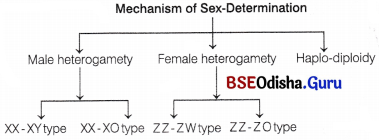
Mechanism of sex-determination
Question 3.
What is male heterozygosity?
Answer:
Male heterozygosity is a type of mechanism of sex-determination in organisms. XX and XY type of sex-determination shows the phenomenon of male heterogamety or heterozygosity because in both these cases, males produce two different types of gametes such as • Either with or without X-chromosome.
- Some gametes with X-chromosome and some with Y-chromosome.
Question 4.
Describe sex-determination in grasshoppers.
Answer:
Grasshoppers have XX-XO method of sex-determination. In this, female has XX and produces homogametic eggs, while male has only one chromosome and produces two types of sperms, e.g. gymnosperms (with X) and angiosperms (without X).
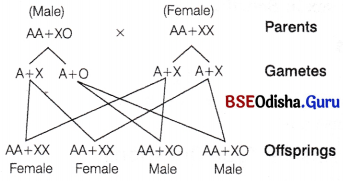
Question 5.
(i) why grasshopper and Drosophila show male heterogamety? Explain.
(ii) Explain female heterogamety with the help of examples.
Answer:
(i) Male heterogamety is shown by male grasshopper and Drosophila, as they both produce two types of gametes having 50% X-chromosomes and other with 50% Y-chromosomes.
(ii) In this case, the total number of chromosomes are same in both males and females. But two different types of gametes having different sex chromosomes are produced by females.
1. ZZ-ZW Mechanism
This mechanism of sex-determination is seen in birds, fowls and fishes. Females have one Z and one W-chromosome (i.e. heterogametic) along with autosomes whereas males have a pair of Z-chromosomes (i.e. homogametic). Thus, the sex of an organism is determined by the type of ovum that is fertilised to produce an offspring.
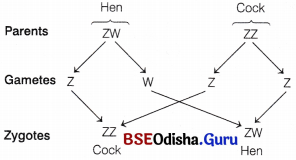
Determination of sex (ZZ-ZW) in fowl and birds
2. ZZ-ZO
In this mechanism of sex-determination, the female is heterogametic (ZO) and male is homogametic (ZZ). It occurs in lepidoptera, e.g. certain butterflies and moths.
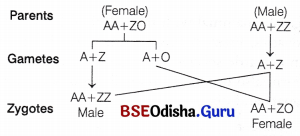
Determination of heterogametic and homogametic female and male
Question 6.
Write the types of sex-determination mechanisms of the following crosses. Give an example of each type.
(i) Female XX with male XO
(ii) Female ZW with male ZZ
Answer:
(i) The type of sex-determination mechanism shown in female XX with male XO is male heterogamety, e.g. grasshoppeer.
(ii) The type of sex-determination mechanism shown in female ZW with male ZZ is female heterogamety, e.g. birds.
Question 7.
Write short note on sex-determination in Bonellia viridis.
Answer:
In Bonellia viridis (worm), the environment determines the sex differentiation. In these, when the young ones are reared alone they develop into females, but when the newly hatched eggs are reared in close proximity to an adult female (i.e. attached to female proboscis) they become male.
This is due to the hormones released by female proboscis which induces larvae to differentiate into males.
Question 8.
What is criss-cross inheritance?
Answer:
Criss-cross inheritance is defined as the inheritance of sex-linked characters transmitted from father to daughter, who pass it on to the grandsons. The trait is expressed only in males in alternate generations, e.g. red-green colours blindness, haemophilia, etc.
Question 9.
What is sex-linked inheritance? Discuss the inheritance of haemophilia in man.
Answer:
Inheritance of Haemophilia:
It is a sex-linked recessive disease, which is transmitted from an unaffected carrier female to some of the male offsprings. Due to this, patient continues to bleed even during a minor injury because of defective blood coagulation and hence, it is also called as bleeders disease. The gene for haemophilia is located on X-chromosome and it is recessive to its normal allele. In this disease, a single protein that is part of cascade of proteins involved in blood clotting is affected.
The possibility of a female becoming a haemophilic is extremely rare because mother of such a female has to be atleast carrier and father should be haemophilic, e.g. females suffer from this disease only in homozygous condition, i.e. XCXC. The haemophilic alleles shows criss-cross inheritance and they follow Mendelian pattern of inheritance. The family pedigree of Queen Victoria (who was a carrier of haemophilia) shows a number of haemophilic individual.
The inheritance is explained below
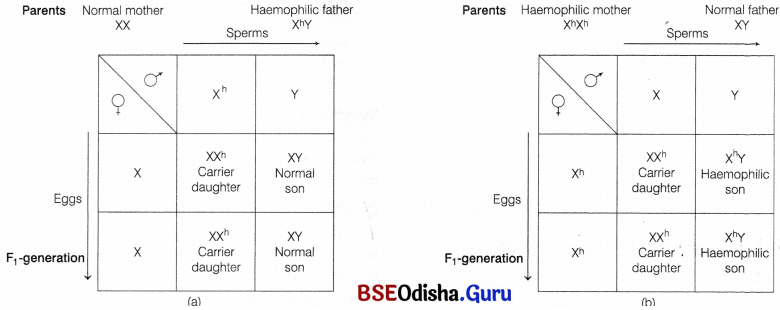
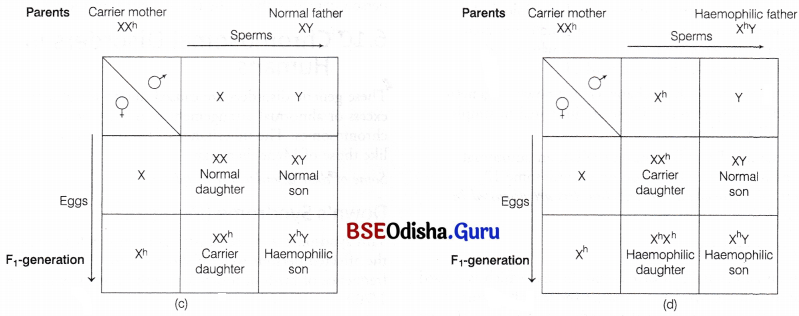
Four crosses explaining the inheritance of haemophilia allele in human ; (a) Normal mother and haemophilic father, (b) Haemophilic mother and normal father, (c) Carrier mother and normal father and (d) Carrier mother and haemophilic father
Question 10.
Haemophilia is a sex-linked inheritance condition in humans where a simple cut causes non-stop bleeding. Study the pedigree chart showing the inheritance of haemophilia in a family. Give reasons, which explain that haemophilia is (i) sex-linked and (ii) caused by X-linked gene.
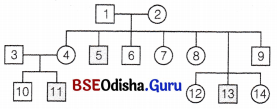
Answer:
(i) Haemophilia is sex-linked because
- It is transmitted from an unaffected carrier female to some of the male offsprings.
- Female rarely becomes haemophilic as her mother has to be atleast a carrier and father should be haemophilic.
(ii) Gene for haemophilia is present on X-chromosome because the heterozygous female for haemophilia may transmit the disease to sons.
Question 11.
What is sex-linked inheritance? Discuss this taking colour blindness as an example.
Answer:
Sex chromosomes contain genes primarily concerned with the determination the sex of the organism. In addition to sex genes, they also contain the genes to control other body characters, thus are called sex-linked genes. The somatic characters whose genes are located on sex chromosomes are known as sex-linked characters. The inheritance of a trait (phenotype) that is determined by a gene located on one of the sex chromosome is called sex-linked inheritance.
Inheritance of Red-Green Colour Blindness
It is a sex-linked recessive disorder, which results in defect in either red or green cone of eye. It does not mean the incapability to see any colour at all, infact it leads to the failure in discrimination between red and green colour. The gene for colour blindness is present on X-chromosome.
It is present mostly in males (XCY) because of the presence of only one X-chromosome as compared to two chromosomes in females. A heterozygous female has normal vision, but is a carrier and passes on the disorder to some of her sons. Its inheritance pattern is similar to that of haemophilia.
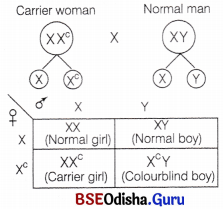
Question 12.
Write short note on inheritance of colour blindness in man.
Answer:
Sex chromosomes contain genes primarily concerned with the determination the sex of the organism. In addition to sex genes, they also contain the genes to control other body characters, thus are called sex-linked genes. The somatic characters whose genes are located on sex chromosomes are known as sex-linked characters. The inheritance of a trait (phenotype) that is determined by a gene located on one of the sex chromosome is called sex-linked inheritance.
Inheritance of Red-Green Colour Blindness
It is a sex-linked recessive disorder, which results in defect in either red or green cone of eye. It does not mean the incapability to see any colour at all, infact it leads to the failure in discrimination between red and green colour. The gene for colour blindness is present on X-chromosome.
It is present mostly in males (XCY) because of the presence of only one X-chromosome as compared to two chromosomes in females. A heterozygous female has normal vision, but is a carrier and passes on the disorder to some of her sons. Its inheritance pattern is similar to that of haemophilia.

Question 13.
If a father and son are both defective in red-green colour vision, is it likely that the son inherited the trait from his father. Comment.
Answer:
No, defective gene for red-green colour vision cannot be inherited from father to his son. Gene for colour blindness is X-chromosome linked and sons receive their sole X-chromosome from their mother, not from their father. Male to male inheritance is not possible for X-linked traits in humans.
In the given case, the mother of the son must be a carrier (heterozygous) for colour blindness gene, thus transmitting the gene to her son.
Question 14.
A colourblind child is born to a normal couple. Work out a cross to show how it is possible. Mention the sex of this child.
Answer:
It is a sex-linked recessive disorder, which results in defect in either red or green cone of eye. It does not mean the incapability to see any colour at all, infact it leads to the failure in discrimination between red and green colour. The gene for colour blindness is present on X-chromosome.
It is present mostly in males (XCY) because of the presence of only one X-chromosome as compared to two chromosomes in females. A heterozygous female has normal vision, but is a carrier and passes on the disorder to some of her sons. Its inheritance pattern is similar to that of haemophilia.

Question 15.
Write the symptoms of Down’s syndrome.
Answer:
The symptoms of Down’s syndrome are
- Broad forehead
- Short and broad neck
- Short and stubby fingers
- Partially open mouth, furrowed tongue
- Mental retardation.
Question 16.
How is the child affected, if it has grown from the zygote formed by an XX-egg fertilised by a Y-carrying sperm? What do you call this abnormality?
Answer:
- The zygote will be XXY. It means the zygote is male with feminine characters.
- This abnormality is called Klinefelter’s syndrome.
Question 17.
Name a disorder, give the karyotype and write the symptoms, where a human male suffers as a result of an additional X-chromosome.
Answer:
The disorder is Klinefelter’s syndrome. It is a chromosomal disorder, which occurs in males. The presence of an additional copy of X-chromosome results in karyotype 44 + XXY.
HF Klinefelter first described this condition in 1942.
This genetic disorder occurs due to the presence of an additional copy of the X-chromosome. It is also known as trisomy of X-chromosome. Its estimated birth frequency is 1/500 live male births.
Genetic Basis
The union of an abnormal XX-egg with a normal Y-sperm or a normal X-egg with an abnormal XY-sperms results in the karyotype of 47, XXY in males or 47, XXX in females.
The abnormal eggs and sperms are formed due to the v primary non-disjunction of X and Y chromosomes during the maturation phase of gametogenesis. Although the usual karyotype of this condition is 47 + XXY but sometimes more complex karyotypes also occurs, e.g. XXXY, XXXXY, XXXXXY, XXXXYY, etc.
Long Answer Type Questions
Question 1.
Explain the chromosomal basis of sex-determination in animals.
Or Give an account of chromosomal theory of sex-determination.
Or Explain the chromosomal theory of sex-determination in animals.
Or Discuss the chromosomal theory of sex-determination in animal’s.
Or Describe the chromosomal basis of sex-determination in human, honeybee and birds.
Or Discuss sex-determination in birds and honey bees.
Answer:
Chromosomal Mechanism of Sex-Determination:
The male and female individuals normally differ in their chromosomal constituents. There are two types of chromosomes, i.e.
- Sex chromosomes or Allosomes The chromosomes responsible for sex determination, e.g. X and Y-chromosomes.
- Autosomes The chromosomes which determines the somatic characters.
X-chromosome was first discovered by Henking (1891). He named this structure as X-body. Scientists further explained that X-body was a chromosome and called it as X-chromosome. The concept of autosomes and allosomes was proposed by Wilson and Stevens (1902-1905) in chromosomal theory of sex-determination.
There are various types of chromosomal sex-determination mechanism observed in different animals as follows

Mechanism of sex-determination
Sex-Determination involving Heterogametic Males:
It is the mechanism in which male produces two different types of gametes. The two conditions that can occur in males are
- Only one X chromosome containing gamete is present.
- Some gametes with X-chromosome and some with Y-chromosome.
(i) XX-XY Type or Lygaeus Mechanism:
This mechanism was first studied by Wilson and Stevens in the milkweed bug called Lygaeus turcicus.
It is present in certain insects like Drosophila melanogaster and mammals including human.
In males, an X-chromosome is present but its other part is very small called as Y-chromosome, whereas, females have a pair of only X-chromosome, i.e. XX.
Both males and females bear same number of chromosomes. The males have autosomes plus XY-chromosomes and females have autosomes plus XX-chromosomes. The males produce two types of gametes containing X or Y sex chromosome (heterogametic) and females produce only one type of gametes with an X-chromosome (homogametic).
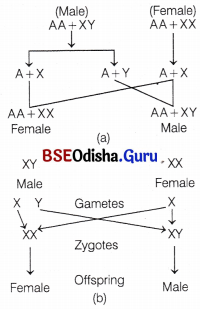
(a) Determination of sex in Drosophila
(b) Pattern of sex chromosomal inheritance in human
Thus, in this type of sex-determination, the presence of Y-chromosomes determines the maleness.
(ii) XX-XO Mechanism
In this pattern, the female has two X-chromosomes (called XX), while male has only one X-chromosome (called XO). The Y-chromosome is completely absent here and it is denoted by the letter O. Thus, the presence of unpaired X-chromosome determines the masculine sex. The female just like the previous method produces, only one type of eggs and male produces two types of sperms, i.e. 50% with one X-chromosome and 50% without any sex chromosome. The sex of offspring depends upon the type of sperm, which fertilises the egg.
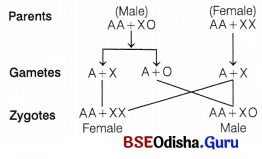
Determination of sex in grasshopper (XX-XO type)
Eggs fertilised by sperms having an X-chromosome become females and those fertilised by sperms that do not have X-chromosome become males, e.g. grasshopper and bugs.
Sex-Determination involving Heterogametic Female:
In this case, the total number of chromosomes are same in both males and females. But two different types of gametes having different sex chromosomes are produced by females.
(i) ZZ-ZW Mechanism
This mechanism of sex-determination is seen in birds, fowls and fishes. Females have one Z and one W-chromosome (i.e. heterogametic) along with autosomes whereas males have a pair of Z-chromosomes (i.e. homogametic). Thus, the sex of an organism is determined by the type of ovum that is fertilised to produce an offspring.

Determination of sex (ZZ-ZW) in fowl and birds
(ii) ZZ-ZO
In this mechanism of sex-determination, the female is heterogametic (ZO) and male is homogametic (ZZ). It occurs in lepidoptera, e.g. certain butterflies and moths.

Determination of heterogametic and homogametic female and male
Question 2.
(i) Also describe as to, who determines the sex of an unborn child?
(ii) Mention whether temperature has a role in sex-determination.
Answer:
(i) As a rule, the heterogametic organism determines the sex of the unborn child. In case of humans, since males are heterogametic it is the father and not the mother who decides the sex of the child.
(ii) In some animals like crocodiles, lower temperature favours the hatching of female offsprings and higher temperature leads to hatching of male offsprings.
This pattern is reversed in Bonellia worm where females are produces in high temperature and males are produced in lower temperature.
Question 3.
Describe various environmental factors that help in sex-determination.
Answer:
Environmental Factors in Sex-Determination:
In some lower animals, sex-determination is non-genetic and depends on the factors present in the external environment.
Different environmental factors responsible for sex-determination are given below
Chemotactic Sex-Determination:
It is seen in males of the marine worm Bonellia. These are small, degenerate and live within the reproductive tract of the larger female. All organs of male worm’s body are degenerate except those of the reproductive system.
In Bonellia, the larvae of male and female are genetically and cytolosically similar, i.e. it is hermaphrodite. A newly hatched worm if reared from a single cell kept in isolation, it develops into a female. If the larvae are reared with mature females in water, they adhere to the proboscis.
Later they transform into males who eventually migrate into the female reproductive tract, where they become parasitic.
It has been found that a chemotactic substance secreted by the proboscis of a mature female Bonellia induces the differentiation of larva into males.
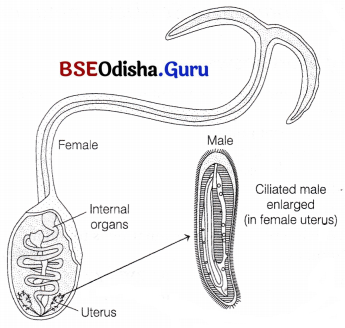
Sex-determination in Bonellia
Temperature Dependent Sex-Determination:
In some reptiles, the temperature at which the fertilised eggs are incubated prior to hatching plays a major role in determining the sex of the offspring. Surprisingly high temperature during incubation have opposite effect on sex-determination in different species.
In turtles, high incubation temperature (above 30°C) of eggs results in the production of female progeny whereas in the lizard and crocodiles, high incubation temperature results in the production of male offspring. At the lower temperature range between 22.5-27°C, male turtles are produced. This pattern is reversed in lizards and crocodiles.
Question 4.
What is sex-linked inheritance? Discuss how sex-linked gene inheritance occurs in human, giving two examples.
Or What is sex-linked inheritance? Discuss the mechanism with reference to haemophilia.
Answer:
Inheritance of Haemophilia
It is a sex-linked recessive disease, which is transmitted from an unaffected carrier female to some of the male offsprings. Due to this, patient continues to bleed even during a minor injury because of defective blood coagulation and hence, it is also called as bleeders disease. The gene for haemophilia is located on X-chromosome and it is recessive to its normal allele. In this disease, a single protein that is part of cascade of proteins involved in blood clotting is affected.
The possibility of a female becoming a haemophilic is extremely rare because mother of such a female has to be atleast carrier and father should be haemophilic, e.g. females suffer from this disease only in homozygous condition, i.e. XCXC. The haemophilic alleles shows criss-cross inheritance and they follow Mendelian pattern of inheritance. The family pedigree of Queen Victoria (who was a carrier of haemophilia) shows a number of haemophilic individual.
The inheritance is explained below


Four crosses explaining the inheritance of haemophilia allele in human ; (a) Normal mother and haemophilic father, (b) Haemophilic mother and normal father, (c) Carrier mother and normal father and (d) Carrier mother and haemophilic father
Inheritance of Red-Green Colour Blindness:
It is a sex-linked recessive disorder, which results in defect in either red or green cone of eye. It does not mean the incapability to see any colour at all, infact it leads to the failure in discrimination between red and green colour. The gene for colour blindness is present on X-chromosome.
It is present mostly in males (XCY) because of the presence of only one X-chromosome as compared to two chromosomes in females. A heterozygous female has normal vision, but is a carrier and passes on the disorder to some of her sons. Its inheritance pattern is similar to that of haemophilia

Question 5.
(i) Why are thalassemia and haemophilia categorised as Mendelian disorders? Write the symptoms of these diseases. Explain their pattern of inheritance in humans.
(ii) Write the genotypes of the normal parents producing a haemophilic son.
Answer:
(i) Thalassemia and haemophilia are categorised as
Mendelian disorders because these disorders are due to alteration in a single gene. Also, they are transmitted to offsprings through Mendelian principles of inheritance. Symptoms and pattern of inheritance are given below
(a) Thalassemia It is an autosomal linked recessive blood disorder characterised by defect in a, (3 and 8 chain resulting in abnormal Hb molecule. Symptom Anaemia.
Inheritance Two mutant alleles (one from each parent) must be inherited for an individual to be affected, i.e. homozygous. Heterozygous are carriers and may pass the mutant allele to children.
(b) Haemophilia It is a sex-linked recessive disorder whose gene is located on X-chromosome. Symptom Prolonged clotting time and internal bleeding, even in a minor injury.
Inheritance The gene is present on X-chromosome, so it is inherited by males as they have a single X-chromosome. Affected males are said to be hemizygous. Females have two X-chromosomes, thus possibility of them being affected is rare as the mother of such female has to be atleast carrier and father should be haemophilic.
(ii) Genotypes of the normal parents producing a haemophilic son are X CX (carrier mother) and XY (father).
Carrier Haemophilic Normal Normal daughter son daughter son
Question 6.
Answer the following questions related to Down’s syndrome.
- When was Down’s syndrome first described?
- What is its frequency in human and does it also occur in other animals?
- How does Down’s syndrome arise?
- Relate it with chromosome dysfunctions.
Answer:
- It was first described in 1866 by J Langdon Down, so it is called Down’s syndrome.
- About 1 in every 750 children exhibits Down’s syndrome throughout the world. It is also seen in chimpanzees and other related primates.
- In humans, it occurs as a result of non-disjunction of chromosome 21 during egg formation. The cause of this primary non-disjunction is not known.
- The defect is associated with a particular small portion of chromosome 21. When this particular chromosome segment is present in three copies, instead of two, due to translocation Down’s syndrome occurs.
